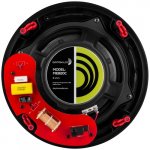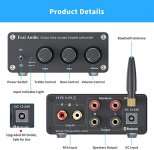Speakers and amps are well matched to each other, and powerful enough for the requirement:
It is not a DJ party space, not a huge theater, etc. so don´t overthink it.
Clearly stated goal is
Again:don´t overthink it.
As suggested above, just wire speaker pairs in parallel to each channel, period.
Factory recommends 14ga wire, so be it.
Amplifier shows banana plugs, speaker drawings appear to show push terminals for bare wire ends, so go to first speaker in a line, uncover 1/2" end, repeat with wire which will continue the path to the second speaker, twist bare ends together and insert in first speaker terminals.
Repeat at the last speaker in the chain, obviously now using just one wire per terminal, since path ends there.
That´s all you need to install them, don´t overthink and complicate this job which is quite straightforward.
small lecture room
It is not a DJ party space, not a huge theater, etc. so don´t overthink it.
Clearly stated goal is
which it will meet and surpass, big time.Audio doesn't have to be top-notch high-end immersive, but it needs to be much better than a standard tv speaker.
Again:don´t overthink it.
As suggested above, just wire speaker pairs in parallel to each channel, period.
Factory recommends 14ga wire, so be it.
Amplifier shows banana plugs, speaker drawings appear to show push terminals for bare wire ends, so go to first speaker in a line, uncover 1/2" end, repeat with wire which will continue the path to the second speaker, twist bare ends together and insert in first speaker terminals.
Repeat at the last speaker in the chain, obviously now using just one wire per terminal, since path ends there.
That´s all you need to install them, don´t overthink and complicate this job which is quite straightforward.
It's not as simple as that.
May I make it clear that I was referring to the OP's amp/speaker combination as it actually exists, and not to some hypothetical scenario.
Amplifier shows banana plugs, speaker drawings appear to show push terminals for bare wire ends...
I've looked at the components, JMF, and can confirm your statement as well as adding images for future reference.
Attachments
Speakers and amps are well matched to each other, and powerful enough for the requirement
Yes, I thought at first that the Fosi amp may be underpowered, but am reassured to see that it comes complete with a 24V/4.5A power supply.
To be fair, the TPA3116 chip is only rated for a 4ohm load on 21V input and running a 24V powersupply as supplied by Fosi is a bit naughty and technically overloading the amplifier. It will allow more current and more power on a 4ohm load than the chip designers have anticipated.May I make it clear that I was referring to the OP's amp/speaker combination as it actually exists, and not to some hypothetical scenario.
The chip even has a mode which 'simulates' a lower voltage powersupply by clipping the signal early to limit the power/current for this exact scenario:
We don't know if Fosi have configured the amplifier to use this feature.7.3.4 PLIMIT Operation
The TPA31xxD2 family has a built-in voltage limiter that can be used to limit the output voltage level below the
supply rail, the amplifier simply operates as if it was powered by a lower supply voltage, and thereby limits the
output power.
As to if you could manage to let out the magic smoke in short order by running those speakers on that amplifier, I doubt it. Put it into thermal protection however? Reduce it's lifespan by causing it to run hot? Maybe.
Last edited:
To be fair, TMM, it's JMFahey that you need to converse with, not me. 🙂
I'll let you two experts argue the pros and cons of the Fosi!
I'll let you two experts argue the pros and cons of the Fosi!
Last edited:
Hello Newish Guy,Greetings all,
I'm not very experienced in DIY Audio, but man I'm loving it!
I'm currently working on a design of a small lecture room, media will be displayed via laser projector to a 150" screen. the design of the space utilizes 4 in-ceiling 8" full-range drives. A laptop will be connected to the projector via HDMI, for ease of use, in which the projector will send the audio signal to an amp powering the speakers.
Audio doesn't have to be top-notch high-end immersive, but it needs to be much better than a standard tv speaker. (budget is very limited)
so the plan is to have a 2 channel amp where two speakers would be wired in parallel to one channel, here are more details
Room dimensions: 7.5m × 4.5m
Audio drives: Dayton Audio ME820C 8" 8-Ohm 45W RMS (×4)
Amplifier: not yet decided, maybe (Fosi Audio BT20A100W + 100W)
I've been reading about parallel vs series connections, Parallel seems fine but there is always a warning about the risk of running it due to increased voltage which can damage equipment. I've searched how voltage is calculated and how to compare it to the amp and speakers specs but couldn't find anything useful. So, what is the procedure and calculation necessary to avoid damaging equipment when connecting speakers in parallel?
I would be grateful for any explanations or comments in general.
Cheers.
Not sure if this was specifically answered but if possible, check that you amplifier can be run into 4 ohm load if it states a 4 ohm load then its yes and wire them in parallel, red to red and black to black and then red and black to the amp. If you are not sure about the amp go parallel red to black, black to red and black and red to amp. If possible, place the 2 drivers as close together as possible., if you turn things up and it distorts, then you probably need a bigger amp, it can be tricky to determine if you are over driving your drivers or running out of power.
Hope this helps.
G.
- Home
- Loudspeakers
- Multi-Way
- Parallel speaker connections voltage risks... how to calculate?

